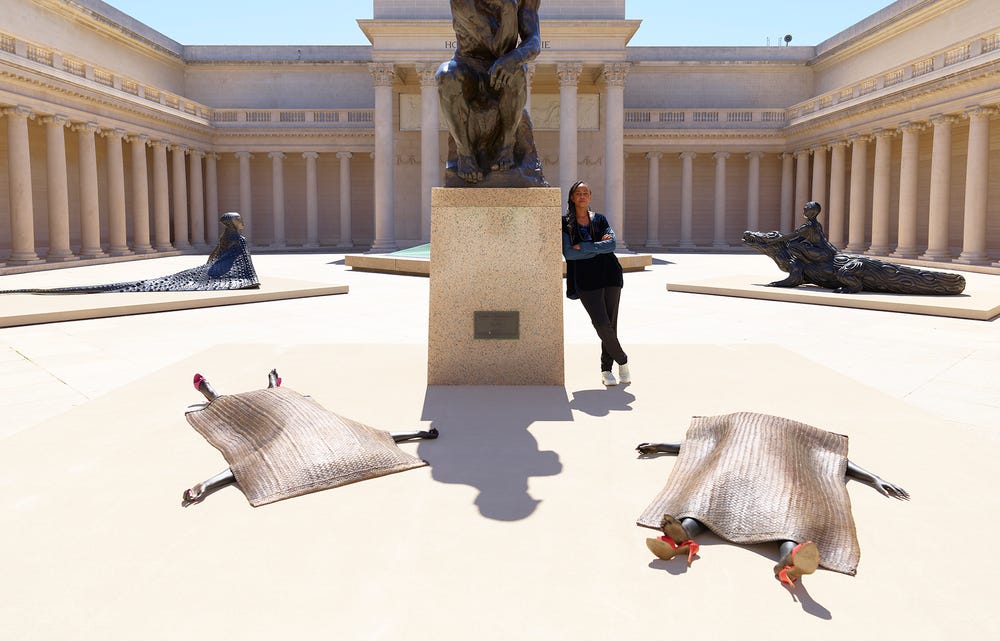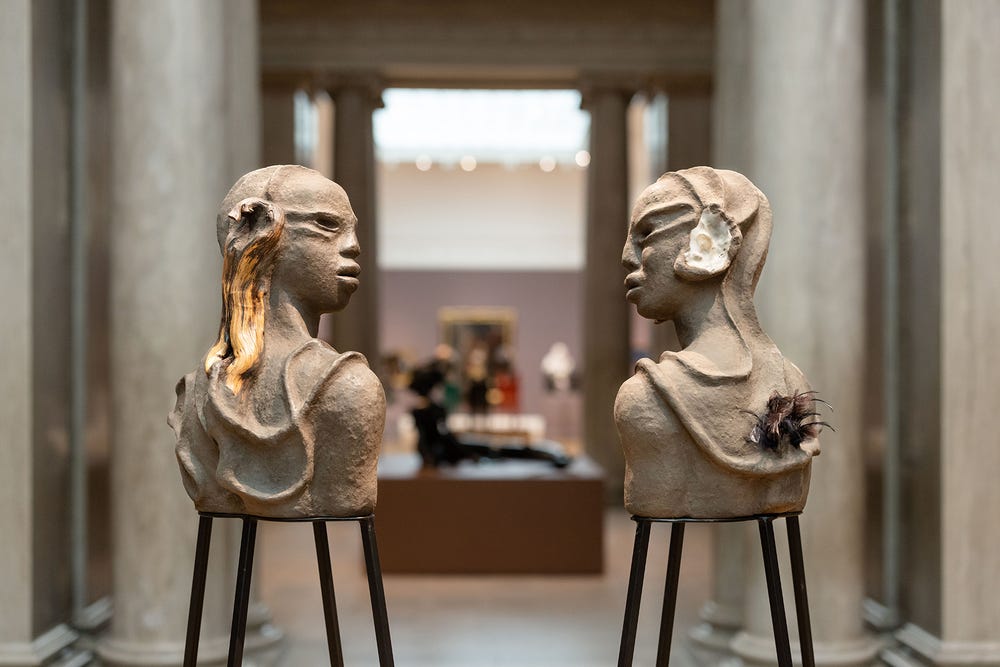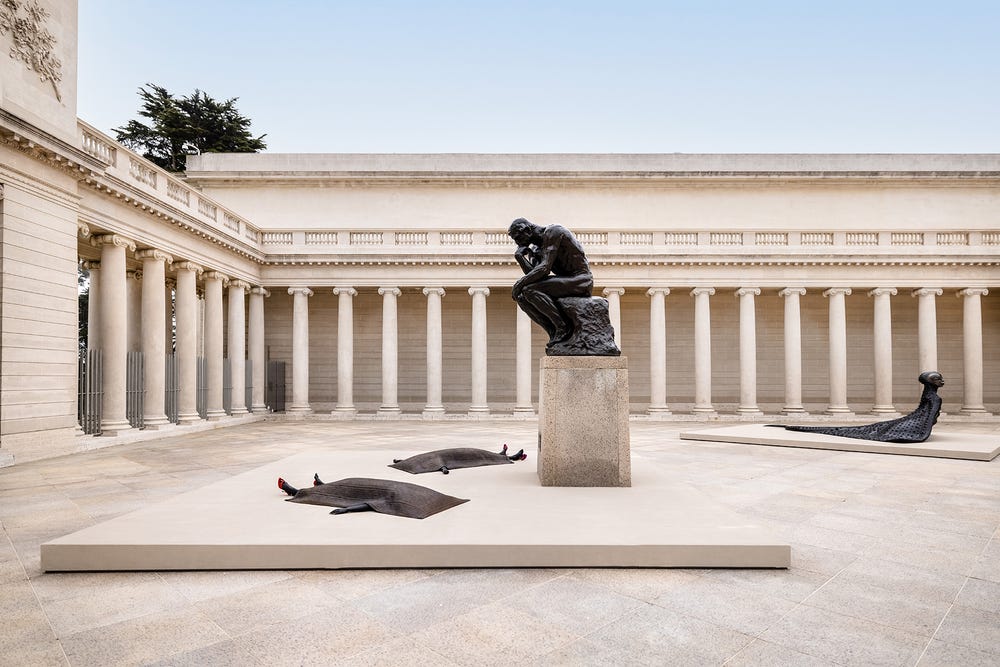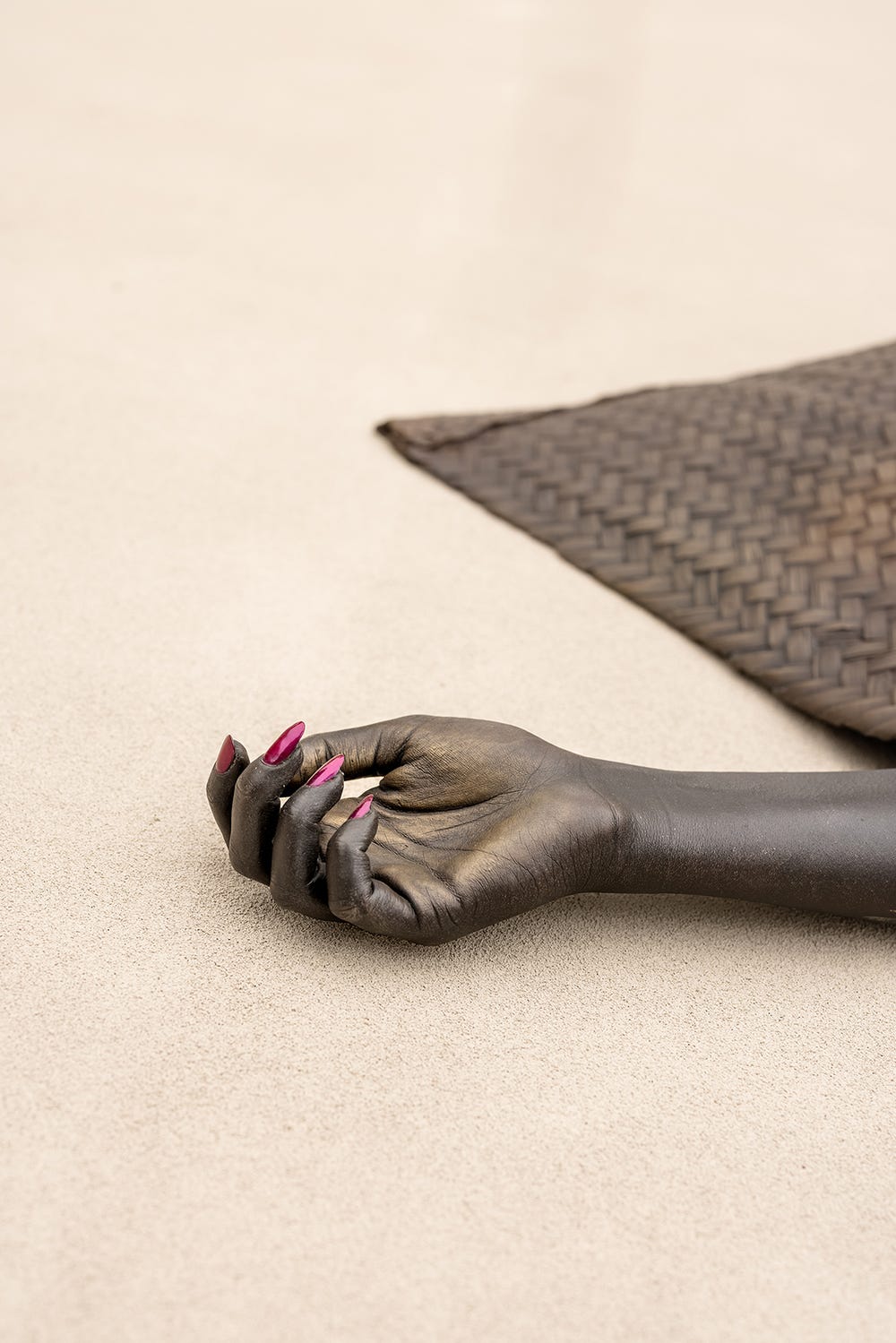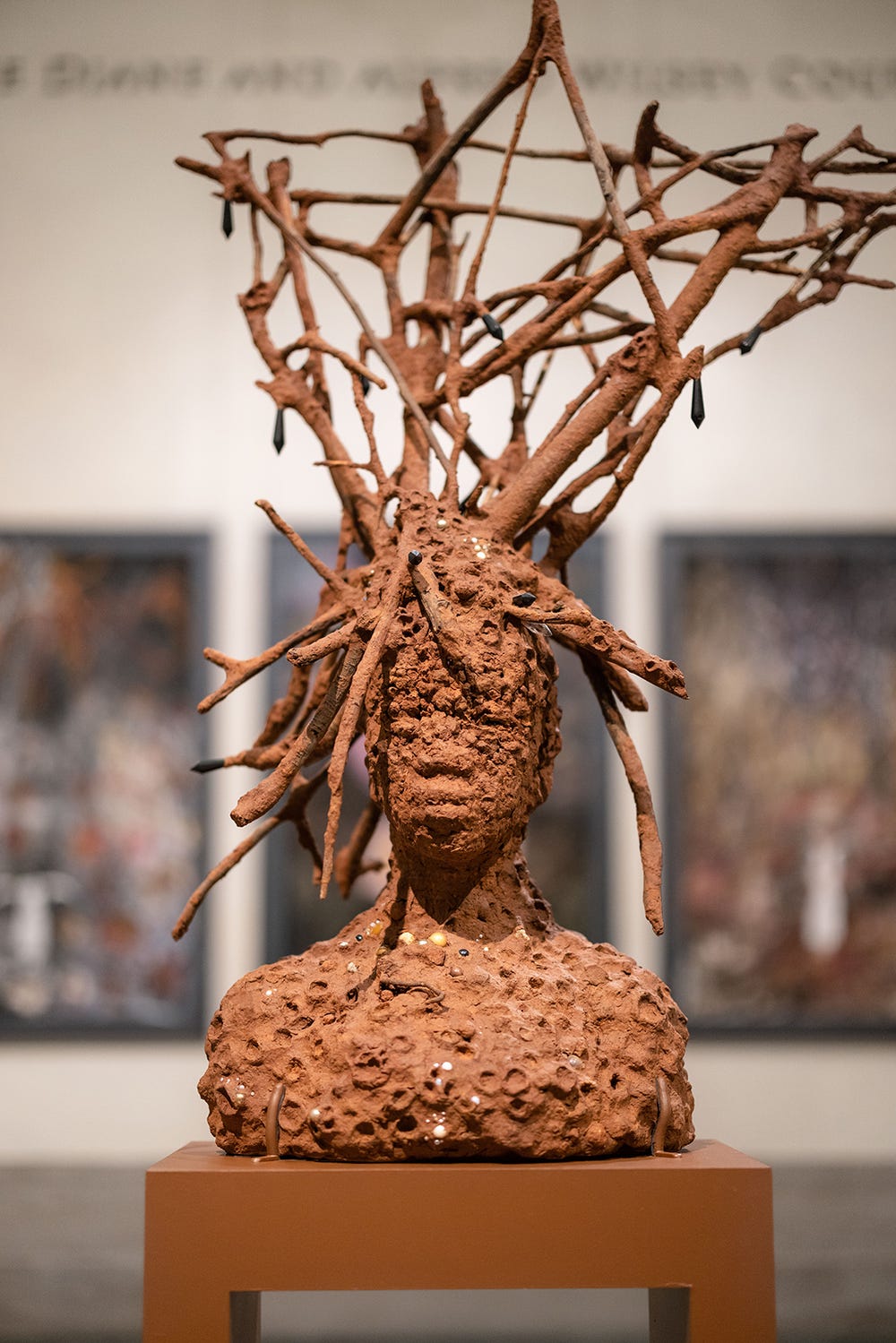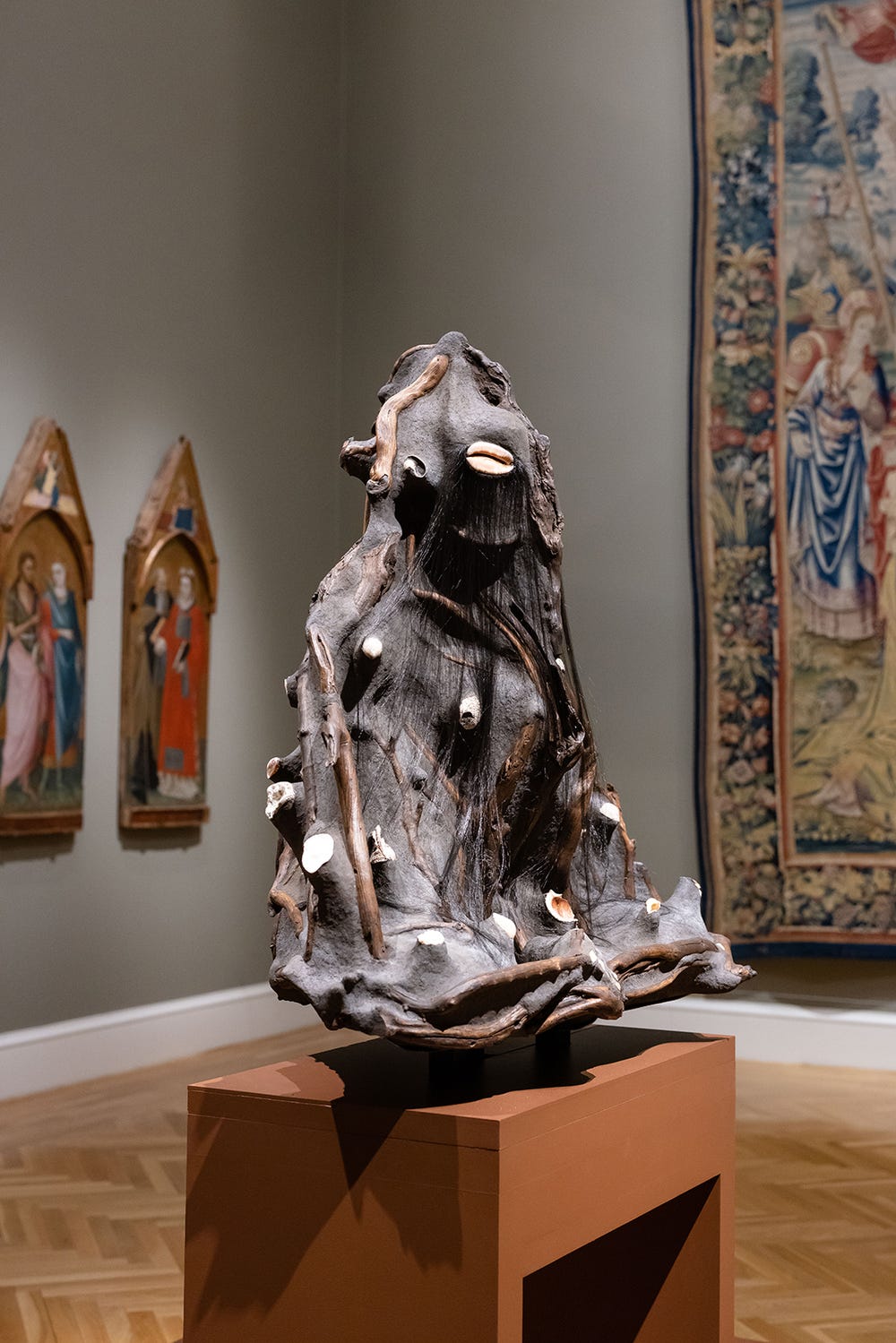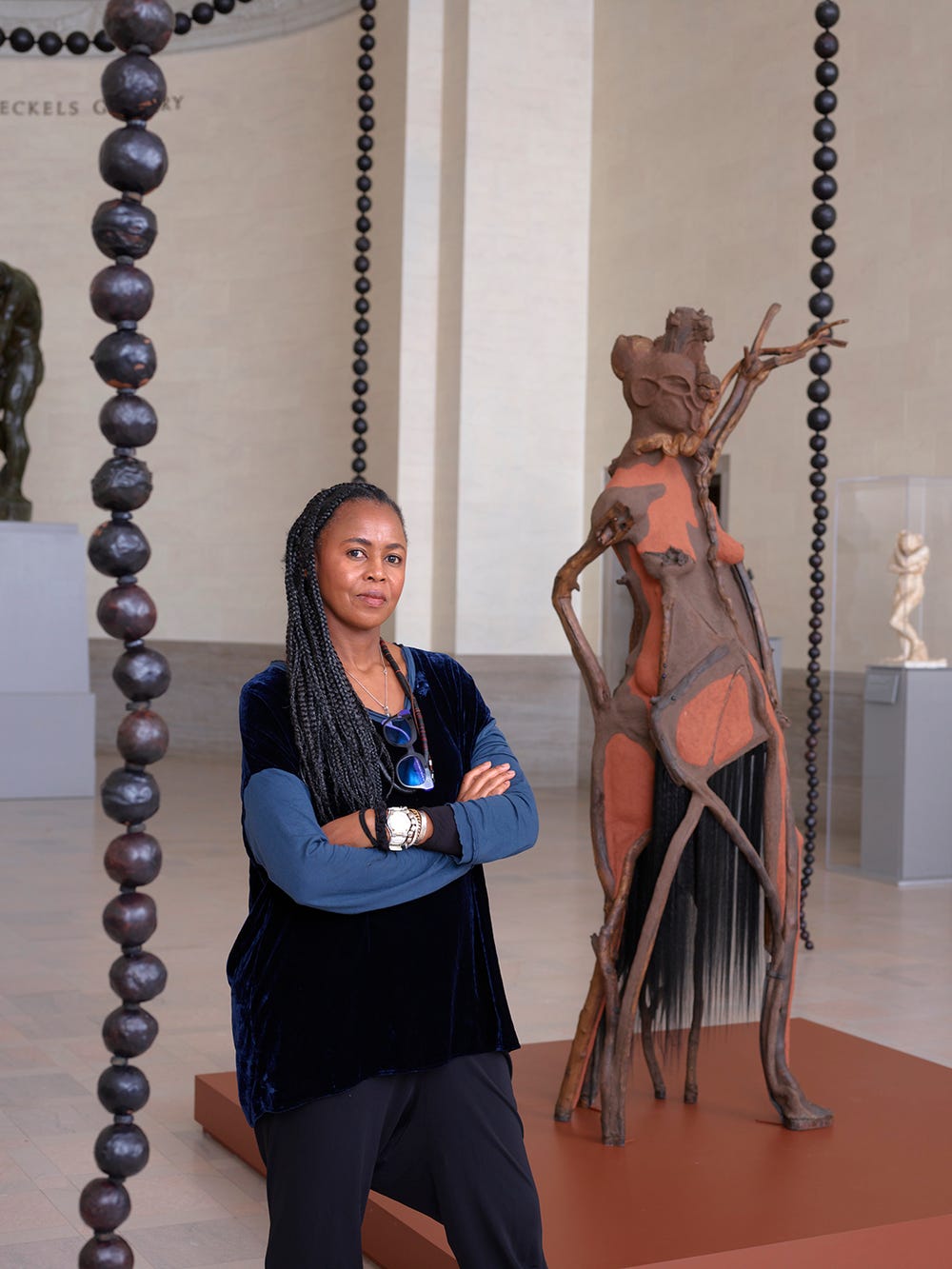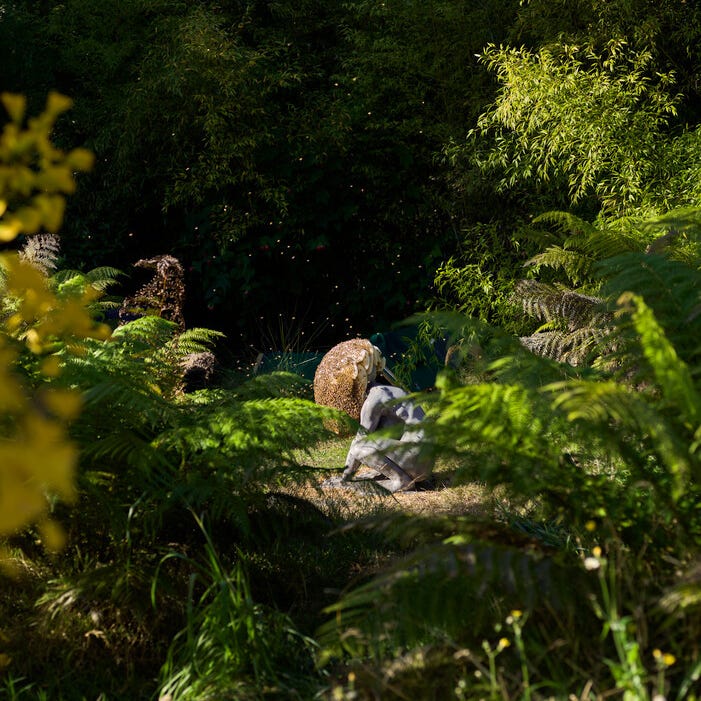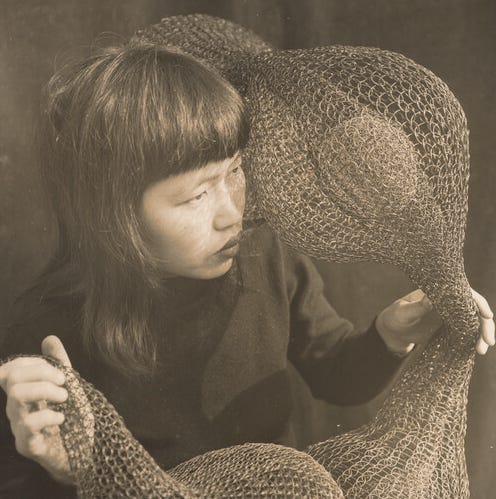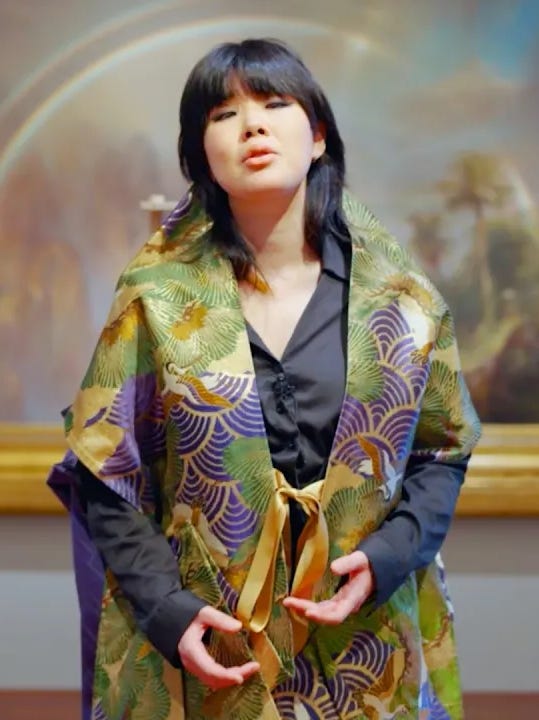On Urgency and Belonging: A Q+A with Wangechi Mutu
By Claudia Schmuckli and Wangechi Mutu
July 8, 2021
I Am Speaking, Are You Listening? is the sixth of an ongoing series of exhibitions conceived with contemporary artists to reflect on the history and identity of the Legion of Honor. The Legion of Honor readily invites such contemplation. Home to the Fine Arts Museums’ collections of European art from antiquity to Impressionism, it embodies the fact that art history in the West, as traditionally narrated, has been the dominion of white patriarchy. The contemporary program at the Legion of Honor shines a light on the exclusionary nature of this version of history by probing, stretching, and disrupting traditional modes of presentation. Each contemporary intervention forges new conversations, stories, and myths that make us think and feel differently about art and its histories of which many have yet to be told. Using the power of art as a harbinger of change, the contemporary exhibitions at the Legion of Honor anticipate the larger systemic changes yet to come, both within society and its institutions of art by proposing different forms of coexistence in space and time.
Claudia Schmuckli:
When I was walking through the museum during installation, one of our staff members came up to me gushing about the exhibition as how it was coming together. But the most meaningful thing she said was that she felt that your work belonged here. And so I wanted to ask you about that sense of belonging.
Wangechi Mutu: I think, what has ignited my inspiration and also probably forced me to constantly reexamine my practice is a slight feeling of discomfort with every place that I feel like I was supposed to be in and where I ended up assuming that I was in the right place.
No matter how much I’ve worried about not belonging, I think it’s been one of the most beneficial cauldrons of my making, because it’s always kept me questioning what that means. What does belonging mean? Where do people come from? Whose home is this? Why? Whose institution is this? Who is it serving? And, are the people who it’s serving today, the people that it will serve tomorrow. Can a place be for everyone, you know, can a home be for all of us? Is it big enough? Is it loving enough?
I think institutions are victims of their society and also children of their society. They can’t behave any better than the societies they come from. So, if the work feels like it belongs, that's a good thing. I hope the people who it belongs to also come to look for it here.
Wangechi Mutu, I Am Speaking, Can You Hear Me?, 2020 © Wangechi Mutu. All rights reserved. Courtesy the artist and Gladstone Gallery, New York and Brussels. Installation view from Wangechi Mutu: I Am Speaking, Are You Listening? at the Legion of Honor. Photography by Gary Sexton
CS: One of the great achievements of your exhibition is that it feels like an offering to this institution, which is so firmly grounded in a particular version of art history that has been shaped in the west, and that has been oblivious or blind to other traditions. For you to bring some of these other histories and stories into play, and doing it so generously and openly is one of the greatest gifts that I think you could have made to an institution like ours.
How do you feel now that you’ve seen the work in situ for the first time? Do you feel that it opens up?
WM: I’m so relieved. I’m so glad to see it up because I didn't know what to expect. We’ve done drawings and we’ve had conversations and we’ve made all of these maps and we’ve spent a lot of time stirring things up with the hope that this will actually happen. A lot of the assumptions and worries that I was having, they softened and disappeared because you cannot describe art from a computer screen. So I'm thrilled. I mean, I’m so lucky I walked into the feast that has already been laid out.
It helps with regards to many things that I was in doubt about, including the fact that I think sometimes you do feel like the problems within institutions, especially traditional institutions, are so insurmountable. They’re so big. It's like, well, what is this small piece of work in here going to do? And I realize a lot, it could do a lot…
CS: Oh, it moves mountains.
WM: We’ve moved a few. Yeah. Quite a bit of soil.
The courtyard I think it’s really spectacular. The relationship to this very powerful classical work, which I have looked at and been taught about, and I now read even more about it because of its proximity to my work.
Shavasana I, 2019 and Shavasana II, 2019, and Mama Ray, 2020. © Wangechi Mutu. All rights reserved. Courtesy the Artist and Gladstone Gallery, New York and Brussels. Installation view of “Wangechi Mutu: I Am Speaking, Are You Listening?” at the Legion of Honor. Photography by Gary Sexton. Images courtesy of the Fine Arts Museums of San Francisco
To have these bodies, especially these women’s bodies, sitting under Rodin’s Thinker, it’s theoretically completely mindblowing, but I think when you see it physically, it’s visceral, and it couldn’t be more creepy and poignant as to how much it reflects this exact moment that we’re having to experience: this moment of recording.
CS: That’s been one of my reflections too. Just the growing urgency that this exhibition has taken on for me, as we had talked about placing the Shavasanas at the base of The Thinker in 2019, when you first started thinking about these works. And it was always a pairing and a placement that seemed really important. But in the wake of the last year, it has assumed even greater and more expansive consequence.
WM: Yeah. It’s sad. I mean, it shouldn’t. I wish it wasn’t.
Wangechi Mutu, Shavasana II (detail), 2019. © Wangechi Mutu. All rights reserved. Courtesy the Artist and Gladstone Gallery, New York and Brussels. Wangechi Mutu: I Am Speaking, Are You Listening? installation in the Court of Honor at the Legion of Honor. Photography by Gary Sexton.
CS: It shouldn’t, but it has. And here it is today, as if it was a reaction to this moment, and yet it wasn't; it was anticipating this moment because it's always been there.
WM: It’s been there for a while, and obviously it’s been in my work for a long time, because I’ve always been completely appalled at how women’s bodies become these remnants of our continual lack of growth and evolution and consciousness.
I think art has a particular role to play [...] because it won’t let you forget. And then you have to update what it is. You're not supposed to forget. Especially if you're still repeating the same things again, and again, and again. I mean, there’s plenty of murders in these paintings and in these rooms.
CS: Oh, everywhere.
WM: But at a certain point you don’t see them anymore, and you don't know why they’re happening, and to whom, and for what reason you, in particular, need to pay attention.
I’m glad that there’s this incredibly important conversation that I’ve had in all of these works I’ve been making all these years. It has continued and it’s still relevant, but I'm also hoping that there is a way to really get into a place of common understanding.
Wangechi Mutu, Dream Catcher, 2016. © Wangechi Mutu. All rights reserved. Courtesy the artist and Gladstone Gallery, New York and Brussels. Installation view from Wangechi Mutu: I Am Speaking, Are You Listening? at the Legion of Honor. Photography by Gary Sexton.
I always say, it doesn’t matter if we don’t. It's not like we’re a separate being from the Earth. Earth is this thing that literally has created us. We’re just the little hairs on its skin. What I worry about is the fact that the Earth is just going to make up its mind on what needs to happen. That’s the part, that’s the image I’m always frightened of, but also curious about how to create, because I’m like: what’s going to happen? Because we will infuriate this thing that we belong to. Because we can't see around it and through it. It’s because we can’t really see what it is, that we can’t see each other.
CS: Going back to your point earlier of what the work communicates in situ. I was wondering whether there were other moments in the exhibition, juxtapositions of your work with other work in the galleries, that particularly jump out at you?
WM: I remember from my first trip here, one of the things that I enjoyed was the rooms with traditional religious work, just because I'm drawn to the absolute, almost absurdity of the images. But I know that there’s such religiosity and at the time that they were made, they were really quite hot pictures of holy, holy things. And because of my schooling, I think I’m drawn to that kind of quasi-pagan imagery where things just collapse into one another, and it becomes almost absurd, you know?
And I think of how we create things and make things so extremely extraordinary, meaningful to the point that they’re dangerous for us, that they’re dangerous for others, that they’re taboo and what it takes to mix pigment and oil and so forth to the point that you are able to represent something that is in your mind better than you and everyone else around you.
Wangechi Mutu, Seeing Cowries, 2020 © Wangechi Mutu. All rights reserved. Courtesy the artist and Gladstone Gallery, New York and Brussels. Installation view from Wangechi Mutu: I Am Speaking, Are You Listening? at the Legion of Honor. Photography by Gary Sexton.
I think of that kind of thing when I’m making these objects. Primarily because I’m using the most fundamental and, I think, sacred materials, which is literally picking up this incredible dust and soil. I do love Seeing Cowries in the medieval gallery, especially now that I’ve seen it with the relics and the unicorns on the side. I mean, what is that? Where are we? It's like Jesus and unicorns. I do love that juxtaposition and that placement in that room.
On April 28, we hosted the seventh Annual Bransten Lecture, where Mutu led an in-depth look at her new exhibition. Interview by Claudia Schmuckli, Curator in Charge of Contemporary Art and Programing, Fine Arts Museums of San Francisco.
Wangechi Mutu. Photography by Randy Dodson.
[This conversation has been edited for length and clarity.]
Wangechi Mutu: I Am Speaking, Are You Listening? is on view at the Legion of Honor through November 7, 2021.
